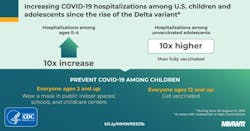CDC report on hospitalizations associated with COVID-19 among children and adolescents, one in four hospitalized children required intensive care
In the weekly Morbidity and Mortality Weekly Report (MMWR), researchers from the Centers for Disease Control and Prevention (CDC) reported that COVID-19–associated hospitalization rates rose rapidly during late June to mid-August 2021 among U.S. children and adolescents aged 0–17 years; by mid-August, the rate among children aged 0–4 years was nearly 10 times the rate 7 weeks earlier.
This increase coincides with widespread circulation of the highly transmissible Delta variant. COVID-NET data indicate that vaccination was highly effective in preventing COVID-19–associated hospitalizations in adolescents during late June to late July 2021. Since March 2020, approximately one in four hospitalized children and adolescents with COVID-19 has required intensive care, although the proportions with indicators of severe disease during the period when the Delta variant predominated were generally similar compared with those earlier in the pandemic.
The observed indicators of severe COVID-19 among children and adolescents, as well as the potential for serious longer-term sequelae (e.g., multisystem inflammatory syndrome in children) documented elsewhere, underscore the importance of implementing multipronged preventive measures to reduce severe COVID-19 disease, including nonpharmaceutical interventions and vaccination among eligible age groups.
Among adolescents aged 12–17 years, the only pediatric age group for whom a COVID-19 vaccine is currently approved, hospitalization rates were approximately 10 times higher in unvaccinated compared with fully vaccinated adolescents, indicating that vaccines were highly effective at preventing serious COVID-19 illness in this age group during a period when the Delta variant predominated.
As of July 31, 2021, 32% of U.S. adolescents had completed a COVID-19 vaccination series; increasing vaccination coverage among adolescents, as well as expanding eligibility for COVID-19 vaccination to younger age groups if approved and recommended, is expected to reduce severe COVID-19–associated outcomes among children and adolescents.
Similar to another recent analysis, COVID-NET data suggest that indicators of severe disease among hospitalized children during an early period when the Delta variant predominated were generally similar to those observed earlier in the pandemic. Trends in outcomes will need to be monitored closely as more data become available.
For example, whereas the point estimate of the proportion of hospitalized children who required IMV during the period of Delta predominance (9.8%) was higher than that earlier in the pandemic (6.1%), the comparison of these proportions was based on a relatively small number of children requiring IMV during the period of Delta predominance, and the difference was not statistically significant.
Further, surveillance data limited to hospitalized persons cannot be used to assess whether increases in COVID-19–associated hospitalization rates among children and adolescents are due to increased community SARS-CoV-2 transmission or increased disease severity caused by the Delta variant.
